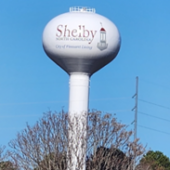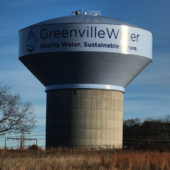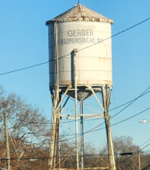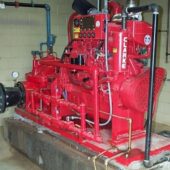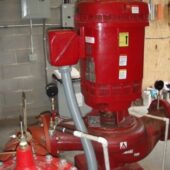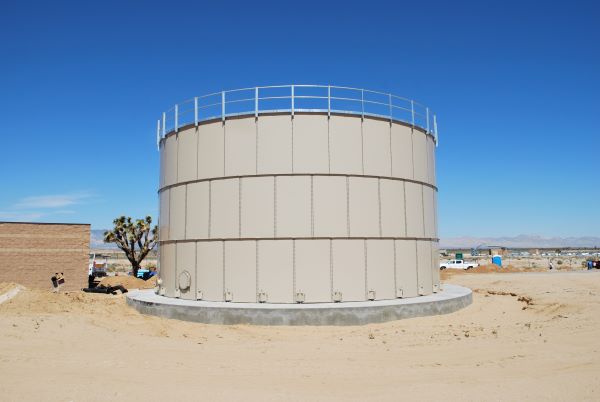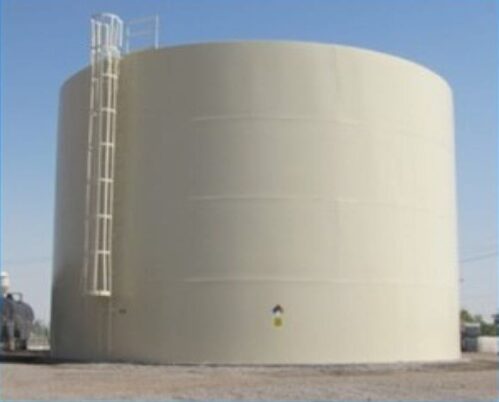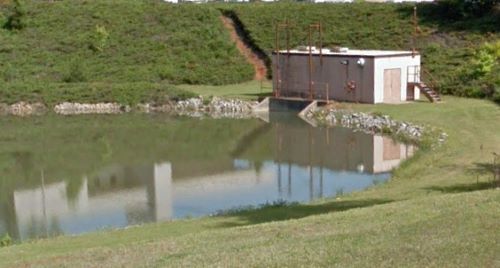Get primed!
Fire protection water supplies can be made up of one or more common elements, including tanks, pumps, water sources and water systems. Sometimes elements are used together to develop an adequate supply for fire protection.
An adequate water supply for a fire protection system will meet the needs of the fire protection system (plus safety factor) in three terms: 1) flow rate, 2) water pressure, and 3) duration. Duration is how long that a given flow rate is needed, or, practically, how long the fire protection system is expected to need to run. If a facility has multiple fire sprinkler systems, the “most demanding” system drives the bus. The “most demanding” system is the one that has the largest flow rate and water pressure needs.
Many fire protection systems are supplied solely by public water systems. The flow rate and water pressure available will vary by the water system and where a site is within the water system. Public water systems are commonly supplied by elevated water storage tanks (AKA gravity tanks) or pumps.
Elevated water storage tanks take many shapes and are common fixtures in many public water systems
If the flow rate and duration available from a public water system are adequate but the water pressure is too low, a booster fire pump can be used to increase the pressure. A booster fire pump draws water from a public water source and simply increases its pressure. A centrifugal-type fire pump would be used, either with an electric motor or diesel engine to drive them.
A diesel engine driven horizontal split-case centrifugal fire pump, left, and an electric motor driven in-line fire pump, right
If the flow rate or duration available from a public water system is too low, or if there is no available public water system, a site needs its own source of water. That source could be a tank (by far the most common), pond, river or well. When I said, “tank”, you may have thought of the elevated gravity tanks so common to public water systems. While a site certainly could have a privately-owned elevated tank, the suction tank is much more common. A suction tank is a ground-level water tank that supplies one or more fire pumps. 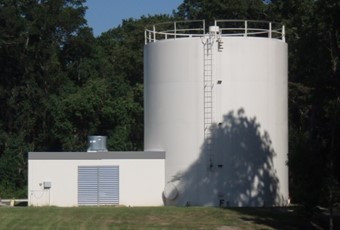 Suction tanks are often filled with water from a public water system, though a well or other water source could be used to fill it and maintain it full. The fire pumps are typically situated in an unassuming-looking building immediately adjacent to the unassuming-looking tank (though the tank can make a nice art canvas).
Suction tanks are often filled with water from a public water system, though a well or other water source could be used to fill it and maintain it full. The fire pumps are typically situated in an unassuming-looking building immediately adjacent to the unassuming-looking tank (though the tank can make a nice art canvas).
Such tanks regularly hold 150,000 to 500,000 gallons and are of welded or bolted construction.
A bolted suction tank, top, and a welded suction tank, bottom (by permission of Superior Tank) From: https://superiortank.com/blog/2017/02/10/bolted-welded-steel-tanks-just-right-fit-fire-protection/
How duration is used to size a tank. The flow rate of water required by a fire protection system multiplied by the duration gives a volume of water. That volume is used to determine how large a water tank is needed. For example, if a fire protection system’s required flow rate is 1200 gpm and the required duration is 2 hours: 1200 gpm X 2 hrs X 60 min/hr = 144,000 gallons. A water source has to provide at least that volume of water. For a suction tank, the size would be bumped to the next one up; in our example, probably to 150,000 gallons.
What about other water sources, like ponds, rivers, wells, or even buried tanks? These can certainly be used! These water sources have no positive pressure of their own relative to ground level. Centrifugal pumps cannot be used with these sources, because there’s a risk of cavitation or loss of pumping if positive pressure is not guaranteed on the suction side of a centrifugal pump. In fire protection, centrifugal pumps cannot rely on foot valves or other methods to maintain priming (at least as of the 1974 edition of NFPA 20), because mechanical priming has proven to be unreliable. Enter now the vertical turbine fire pump, which pairs perfectly with water sources where the water level is below the pump. Priming is no problem for the vertical turbine pump, which lifts water using stacked suction bowls.
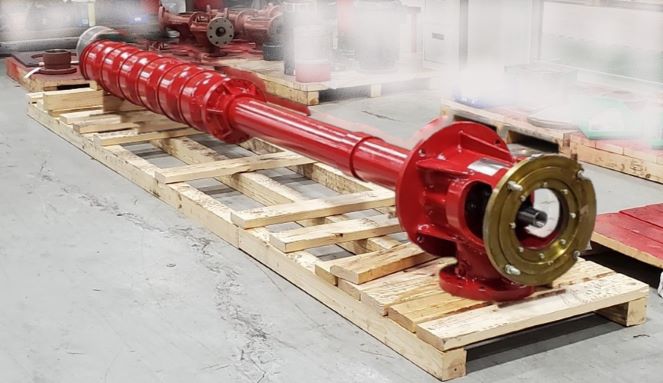
A vertical turbine fire pump. The top of the pump is closest; the bottom the farthest away. (photograph by the author, at the SPP factory).
With ponds and rivers, a vertical turbine fire pump would draw water from a suction well that is situated below the building in which it is located. The entrance to the suction well is protected by screens to exclude debris and larger objects, like fish.
A pump house for vertical turbine fire pumps on a pond. The hatches on the roof facilitate installation or removal of the pumps for any necessary work (Google Earth Street View)
In a few places above, I hinted that there may be more than one fire pump present. Indeed, there is sometimes more than one fire protection water supply at a location. Reliability and redundancy are foundational in fire protection. For these reasons it’s not uncommon to see multiple redundant fire pumps with different driver types (electric and diesel), or multiple water supplies on opposite sides of a large manufacturing or warehousing facility. Another evidence of reliability is the provision of an emergency power generator for an electric fire pump. Such contingencies also allow for full fire protection to be maintained even if one part of the system is down in need for outage, repair, inspection, or maintenance.
Sometimes, more than one pump or tank is provided, and it’s not only for redundancy and reliability. Sometimes, the most demanding fire protection design case isn’t a single system; it’s multiple systems that need to operate all at once. Consider an outdoor chemical complex that may have several deluge systems protecting one process block. The design case could involve a flow rate of thousands of gallons per minute. What then? In these cases, multiple fire pumps could be employed and their flow rates combined in order to supply a large flow rate.
As you can see, a fire protection water supply can be quite simple, with just a public water supply alone supplying the needed flow rate, water pressure and duration. A fire protection water supply can equally be quite complex, with risk analysis, future maintenance needs, reliability, combined system demands as factors in a design of a system which will provide for the protection of a large manufacturing complex.
Amy Anderson, PE, CFEI, has a Bachelor of Science in Chemical Engineering from Clemson University and is a licensed Professional Engineer in Fire Protection, as well as a Certified Fire and Explosion Investigator. Amy has over 20 years of engineering experience including property loss prevention engineering specializing in fire protection, chemical and pharmaceutical facilities. She has partnered with clients to identify, assess, avoid, and reduce risk at their commercial and industrial properties. Additionally, she has assisted with the development of building and fire protection specifications, reviewed plans and performed site visits. She has reviewed project documents for compliance with applicable standards – construction, fire protection, process, and combustible dust hazards. Amy is a member of the National Association of Fire Investigators, the Society of Fire Protection Engineers, the National Fire Protection Association and the American Institute of Chemical Engineers.



